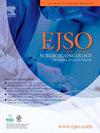乳房x线摄影和病理尺寸的差异:危险因素和对同侧复发率的影响
IF 2.9
2区 医学
Q2 ONCOLOGY
引用次数: 0
摘要
背景:乳腺导管原位癌的乳腺x线摄影和病理尺寸的差异可能导致手术过度治疗,导致较差的美容或不必要的乳房切除术,或治疗不足和复发。方法:在英国Sloane项目筛查DCIS的前瞻性队列研究(2003-2012)中,我们研究了与“病理较大(PL)”(病理大于乳房x线摄影尺寸)或“乳房x线摄影尺寸较大(ML)”(乳房x线摄影尺寸大于病理尺寸)、尺寸差异和对同侧复发的影响相关的因素。结果在9937例患者中(平均年龄60岁,范围46-87岁),乳腺x线片尺寸中位数保持在19 mm (IQR 10-35)mm,而病理尺寸从16(10-28)mm增加到20(10-33)mm (p = 0.001)。x线和病理尺寸差异从3.4 mm减少到0.2 mm (p < 0.05)。在接受BCS的患者中,如果病变为PL(优势比(OR) 1.37 (C.I. 1.03-1.82, p = 0.03),如果病变为ML (OR) 1.4 (C.I. 1.10-1.86, p = 0.008),则≥5mm的差异与5年同侧复发增加相关。与PL≥5mm相关的因素是高分级(OR为1.9 [95% CI 1.5-2.4, p < 0.001])和乳房切除术(OR为4.4 [CI . 1])3.8-5.1, p < 0.001]), ML≥5 mm的乳房x线摄影肿瘤大小较大(>40 mm; OR 115.7 [C.I.][82.3-162.6], p < 0.001])。结论乳腺造影-病理尺寸差异与DCIS BCS术后高复发率相关。本文章由计算机程序翻译,如有差异,请以英文原文为准。
Discrepancy between mammographic and pathological sizing of screen-detected DCIS: Risk factors and impact on ipsilateral recurrence rates
Background
Discrepancy between mammographic and pathological sizing of DCIS can lead to surgical overtreatment, with poorer cosmesis or unnecessary mastectomy, or undertreatment and recurrence.
Methods
Within the UK Sloane Project prospective cohort study of screen-detected DCIS (2003–2012), we investigated factors associated with 'pathology larger (PL)’ (pathological larger than mammographic size) or ‘mammogram larger (ML)’ (mammographic larger than pathologic size), size discrepancy and the impact on ipsilateral recurrence.
Results
Among 9937 patients (mean age 60; range 46–87), mammographic size remained constant at median 19 mm (IQR 10–35)mm whilst pathological size increased from 16(10–28)mm to 20(10–33)mm (p = 0.001)over the study. The mammographic and pathological size discrepancy decreased from 3.4 mm to 0.2 mm (p < 0.05).
In patients undergoing BCS, size discrepancy of ≥5 mm was associated with increased 5-year ipsilateral recurrence if lesions were PL (odds ratio(OR) 1.37 (C.I. 1.03–1.82, p = 0.03) and if lesions were ML (OR 1.4 (C.I. 1.10–1.86, p = 0.008), compared to <5 mm discrepancy.
Factors associated with PL by ≥ 5 mm were high grade (OR 1.9 [95 % CI 1.5–2.4, p < 0.001]) and mastectomy (OR 4.4 [C.I. 3.8–5.1, p < 0.001]) and for ML ≥ 5 mm was larger mammographic tumour size (>40 mm; OR 115.7 [C.I. 82.3–162.6], p < 0.001]).
Conclusion
Mammographic-pathological size discrepancy is associated with higher recurrence following BCS for DCIS.
求助全文
通过发布文献求助,成功后即可免费获取论文全文。
去求助
来源期刊

Ejso
医学-外科
CiteScore
6.40
自引率
2.60%
发文量
1148
审稿时长
41 days
期刊介绍:
JSO - European Journal of Surgical Oncology ("the Journal of Cancer Surgery") is the Official Journal of the European Society of Surgical Oncology and BASO ~ the Association for Cancer Surgery.
The EJSO aims to advance surgical oncology research and practice through the publication of original research articles, review articles, editorials, debates and correspondence.
 求助内容:
求助内容: 应助结果提醒方式:
应助结果提醒方式:


